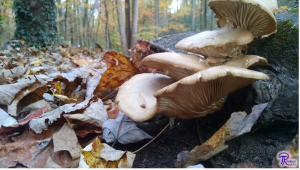#031: Mushroom Morphology: Toothed Fungi
As you might suspect, toothed fungi are defined by a hymenium (spore surface) that consists of spines or teeth. On larger mushrooms this ends up looking something like a bunch of hedgehog quills stuck onto the bottom of a mushroom. These teeth are always oriented straight down, perpendicular to the ground. They are also always tapered to a point. These two characteristics ensure that falling spores do not land on the spines as they fall. Aside from these two characteristics, the toothed fungi can form a variety of different shapes. One of the most commonly eaten toothed fungi, Hydnum repandum (commonly known as the “Hedgehog Mushroom”), has a pileus and central stipe that is reminiscent of a classic “mushroom” or toadstool. Others, like Steccherinum ochraceum, lie flat against their substrate (resupinate) and produce small teeth. Sometimes resupinate fungi make teeth that are little more than bumps on their hymenium. Some of the most impressive toothed fungi fruit as large clumps of long teeth. One such species, Hericium americanum (variously known the “Pom-Pom Mushroom,” “Lion’s Mane,” “the Bear’s Head” “Tooth Fungus,” or “Monkey Head”), ends up looking like a frozen waterfall on the side of a tree. A related species, Hericium erinaceus (which is more deserving of the name “Pom-Pom Mushroom”), looks like a white, spiky ball affixed to the side of a tree. There are also a number of poroid mushrooms that produce teeth. In mushrooms such as Irpex lacteus and Trichaptum biforme the pores erode as the mushroom ages, resulting in tooth-like structures.
Toothed fungi fill a few different environmental roles. The Hedgehog Mushroom and other terrestrial (growing on the ground), toothed fungi with a central stipe are mycorrhizal. The two Pom-Pom mushrooms (Hericium americanum and H. erinaceus) are parasitic, but can continue growing as saprobes after their host tree has died. All the other fungi mentioned above are saprobic.
The toothed mushrooms include a number of good edibles. The most notable edible mushrooms in this group are Hydnum repandum and those in the Hericium genus. Although no toothed mushrooms are poisonous, many are too tough, woody, or bitter to be considered edible. Mushrooms in the Hericium genus all look very similar, especially when young and fresh. Luckily, none of them contain toxins and they all have a similar taste and texture. So, if you are collecting them to eat you don’t need to worry about identifying them to species.
The toothed fungi are a polyphyletic group found in 13 different families across 10 different orders. Almost every major order of mushroom-forming basidiomycetes has at least one species with a toothed hymenium. See Tom Volk’s page on Hericium americanum (linked below*) for the list of families. The orders that include toothed fungi are: Agaricales, Ariculariales, Boletales, Cantharellales, Corticales, Gomphales, Hymenochaetales, Polyporales, Russulales, and Thelephorales. Recognize any of those names? If you’ve been keeping up with FFF, you can see that the toothed fungi are found alongside agarics, boletes, chanterelles, and polypores, among others.
This post does not contain enough information to accurately identify any mushroom. Never eat any mushroom without using a field guide to identify it. If you need a free, quality field guide, I recommend Michael Kuo’s MushroomExpert.com.
See Further:
http://www.mushroomexpert.com/toothed.html
http://website.nbm-mnb.ca/mycologywebpages/NaturalHistoryOfFungi/ToothFungi.html







![#011: Characteristics of Kingdom Fungi [Archived]](https://www.fungusfactfriday.com/wp-content/themes/hueman/assets/front/img/thumb-small-empty.png)

